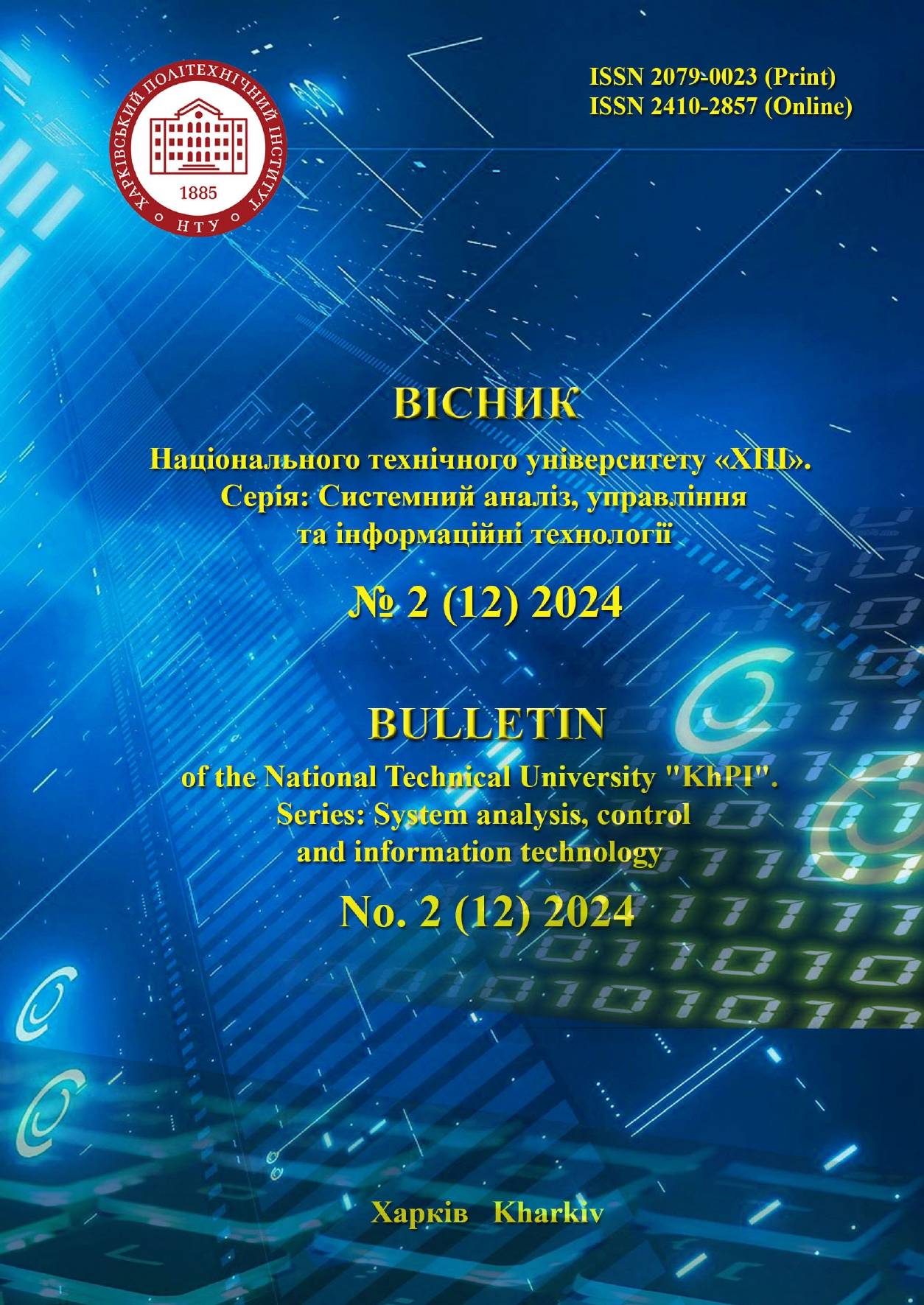APPLICATION OF OPTICAL CHARACTER RECOGNITION AND MACHINE LEARNING TECHNOLOGIES TO CREATE AN INFORMATION SYSTEM FOR AUTOMATIC VERIFICATION OF OFFLINE TESTING
DOI:
https://doi.org/10.20998/2079-0023.2024.02.10Keywords:
information system, web platform, IT project, machine learning, neural networks, algorithm, IAM dataset, optical character recognition, testing, educational processAbstract
During the learning process in any field, testing and monitoring the knowledge of students or other learners is an essential part. Teachers often spend considerable time grading large volumes of standardized tests. While online testing systems have been developed to streamline this process, offline paper tests remain popular as they do not require access to computers, electricity, or a stable internet connection. Offline testing is often considered one of the most representative methods for assessment, but it leads to repetitive work for teachers during the grading process. To save time, some educators use test sheets to structure responses, simplifying grading tasks. Consequently, developing a system that automates the grading of offline tests has become increasingly relevant. The purpose of this research was to develop an information system (web platform) that simplifies the offline test grading process using optical character recognition technologies powered by machine learning algorithms. The object of this research is the processes and functionality involved in creating an information system for the automated grading and evaluation of offline tests. The scientific novelty lies in integrating machine learning algorithms with modified image processing algorithms to create a system capable of analyzing and grading a wide range of offline test tasks, including open-ended, closed-ended, sequence identification, and multiple-correct-answer questions. The practical significance of this research is the development of a web platform to automate offline test grading through optical character recognition and machine learning technologies, reducing teachers' time spent on grading, enabling analysis and improvement of educational programs, supporting various test types, and promoting scientific and technological advancement in education. The developed system can recognize handwritten text from photos, create an array of responses, and compare them to the answers provided by the teacher. This approach significantly reduces the time teachers spend on grading tests. For user convenience, a minimalist interface was created, granting access to all main system functions with intuitive controls. A detailed description of the developed algorithms and machine learning models is provided. This project offers broad potential for further development, including integration with other educational platforms, enhancements in recognition technology, and system scalability.
References
ZipGrade: Touchless grading when in class, online & remote for students that are not. Available at: https://zipgrade.com (accessed 04.10.2024).
GradeCam: Assessment made easy. Available at: https://gradecam.com (accessed 03.10.2024).
Essay Grader for Quality Assessment. Available at: https://edubirdie.com/essay-grader (accessed 04.10.2024).
Klieshch D., Fedorchenko V. Аnalysisof approaches to solving the problem of picture recognitionusing artificial intelligence. Management, Navigation, and Communication Systems. Available at: https://journals.nupp.edu.ua/sunz/article/view/2835/2243 (accessed 06.10.2024).
Axler G., Wolf L. Toward a Dataset-Agnostic Word Segmentation Method. Available at: https://ieeexplore.ieee.org/document/8451570 (accessed 06.10.2024).
Arivazhagan M., Srinivasan H., Srihari S. N. A statistical approach to line segmentation in handwritten documents. Available at: https://cedar.buffalo.edu/~srihari/papers/SPIE-2007-lineSeg.pdf (accessed 06.10.2024).
Manmatha R., Srimal N. Scale space technique for word segmentation in handwritten documents. Available at: https://works.bepress.com/r_manmatha/11/ (accessed 08.10.2024).
Azmi R., Mohseni A., Maleki S., Layeghi K. Handwriting Recognition: A Comprehensive Review. Available at: https://civilica.com/doc/924197 (accessed 08.10.2024).
Awad M. & Khanna R. Hidden Markov Model. Available at: https://doi.org/10.1007/978-1-4302-5990-9_5 (accessed 09.10.2024).
Graves A., Fernández S., Gomez F., Schmidhuber J. Connectionist temporal classification: Labelling unsegmented sequence data with recurrent neural networks. Available at: https://www.cs.toronto.edu/~graves/icml_2006.pdf (accessed 10.10.2024).
Chowdhury A., Vig, L. An Efficient End-to-End Neural Model for Handwritten Text Recognition. Available at: https://arxiv.org/abs/1807.07965 (accessed 05.10.2024).
Puigcerver J. Are Multidimensional Recurrent Layers Really Necessary for Handwritten Text Recognition? Available at: https://doi.org/10.1109/ICDAR.2017.20 (accessed 10.10.2024).
Zhang Hui, Yao Quanming, Kwok James, Bai Xiang. Searching a High-Performance Feature Extractor for Text Recognition Network. Available at: https://doi.org/10.48550/arXiv.2209.13139 (accessed 12.10.2024).
IAM Handwritimg Database. Available at: https://fki.tic.heia-fr.ch/databases/iam-handwriting-database (accessed 10.10.2024).
Ziuziun V. Analysis of the impact of information technologies for making management decisions, including project ones. Available at: https://www.researchgate.net/publication/371492759_Analysis_of_Aspects_of_Increasing_the_Efficiency_of_IT_Project_Management (accessed 10.10.2024).
Ziuziun V. Substantiation of the importance of the role of using information technologies in business process reengineering. Available at: https://doi.org/10.46299/ISG.2023.1.32 (accessed 10.10.2024).
Kronecker Delta. Available at: https://mathworld.wolfram.com/KroneckerDelta.htm (accessed 10.10.2024).
Ziuziun V., Petrenko N. Formation of Conceptual and Logical Databases for the Project of Creating a Web Platform for Automated Verification and Evaluation of Written Tests. Available at: https://www.researchgate.net/publication/Formation_of_Conceptualand_Logical_Database (accessed 13.10.2024).
OpenCv Perspective Transformation. Available at: https://medium.com/analytics-vidhya/opencv-perspective-transformation-9edffefb2143 (accessed 15.10.2024).
MVC Design Pattern. Available at: https://www.geeksforgeeks.org/mvc-design-pattern (accessed 15.10.2024).
Machine Learning Mastery: A Gentle Introduction to Transfer Learning for Deep Learning. Available at: https://machinelearningmastery.com/transferlearning-for-deep-learning (accessed 15.10.2024).
Downloads
Published
How to Cite
Issue
Section
License

This work is licensed under a Creative Commons Attribution 4.0 International License.
Authors who publish with this journal agree to the following terms:
- Authors retain copyright and grant the journal right of first publication with the work simultaneously licensed under a Creative Commons Attribution License that allows others to share the work with an acknowledgement of the work's authorship and initial publication in this journal.
- Authors are able to enter into separate, additional contractual arrangements for the non-exclusive distribution of the journal's published version of the work (e.g., post it to an institutional repository or publish it in a book), with an acknowledgement of its initial publication in this journal.
- Authors are permitted and encouraged to post their work online (e.g., in institutional repositories or on their website) prior to and during the submission process, as it can lead to productive exchanges, as well as earlier and greater citation of published work (See The Effect of Open Access).


